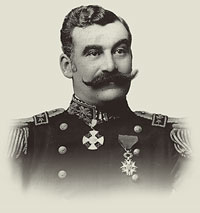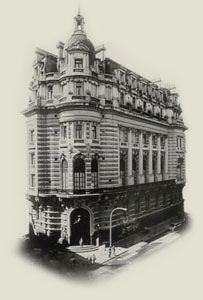History
The Centro Naval opens its doors

The Centro Naval –Naval Center– was founded on May 4, 1882 by a group of almost 24-year-old Argentine Navy Officers from the Naval Academy first Classes, who were seeking to enhance the prestige of the naval profession.
The foundation of the Centro Naval by this group of young Naval Officers was supported by Naval Academy professors, civilians and people from the press, and was concurrent with the creation of the so-called “generation of ’80”, the governing elite formed in Argentina in the 1880s.
The primary purpose of the Centro Naval` was to provide a forum where Naval Officers could meet in an atmosphere of comradeship, openly express their interests and concerns, hold conferences on naval technological progress, and discuss the outcomes of its members’ explorations, discoveries and experience. And apart from spreading specialist knowledge, they could also introduce modern and updated concepts of naval leadership.
The charter signed by the founders specifically states the purpose of the new entity: “To keep the esprit de corps among the Navy’s Officers and put and end to the miserable emulations that delay the Navy’s progress”. The official motto adopted for the Centro Naval –“Union and Work”– also described the founders’ aspirations.
In the first meeting held at Navy Sub-Lieutenant Santiago Albarracin’s residence, the first Steering Committee was set up: Navy Lieutenant Manuel García Mansilla was appointed Chairman, General Benjamín Victorica, Minister of War and the Navy, and General Domingo Faustino Sarmiento, founder of the Naval Academy, were appointed Honorary Chairmen.
Founders of the Centro Naval
Navy Sub-Lieutenant Santiago J. Albarracín
Navy Lieutenant Manuel García y Mansilla
Navy Lieutenant Eduardo O'Connor
Navy Lieutenant Eduardo Lan
Navy Lieutenant Francisco S. Rivera
Navy Lieutenant Miguel Lascano
Navy Sub-Lieutenant Félix Dufourq
Navy Sub-Lieutenant Enrique M. Quintana
Navy Sub-Lieutenant Onofre Betbeder
Navy Sub-Lieutenant Julio Hictce
Navy Sub-Lieutenant Manuel Barraza
Navy Sub-Lieutenant Mariano Saracho
Purser Commisioner Carlos J. Barraza
Professor of Naval Academy Luis Pastor y Teruel
Professor of Naval Academy Teodoro Rose
Professor of Naval Academy Pablo Canevali
Professor of Naval Academy Alberto Smerschow
Senior Officer of the Navy Undersecretariat Benito Goyena
Director of the Navy Secretariat Section Alejandro Albarracín
Navy Lieutenant Juan Picasso
Navy Lieutenant Leopoldo Funes
Navy Captain Andrés E. Gómez
Navy Captain Luis D. Cabral
Navy Lieutenant Emilio Barilari
Navy Lieutenant Agustín del Castillo
Navy Lieutenant Atilio S. Barilari
Navy Lieutenant Hipólito Oliva
Navy Lieutenant Guillermo Pintos
Navy Captain Carlos Sarmiento
Navy Captain Guillermo Mac Carthy
Navy Lieutenant Manuel Domecq García
Navy Lieutenant n José E. Durand
Navy Captain Jorge H. Barnes
Navy Captain Cándido de Eyroa
Navy Captain Francisco Villarino
Navy Captain Federico Mourglier
Navy Sub-Lieutenant Gregorio Aguerriberry
Navy Sub-Lieutenant Fernando Muzas
Professor of Naval Academy Enrique Stein
Professor of Naval Academy Emilio Sellstrom
Professor of Naval Academy Ángel Pérez
The beginning
The 1880s were promising and optimistic times, and shortly after its foundation, the Centro Naval began to publish the “Centro Naval Bulletin”. The bulletin originally came out in a hand-written version, and the first printed issue was available in September 1882. The Centro Naval Bulletin was, and continues to be, a permanent channel of communication and source of specialized information, constituting one of the oldest house organs in Argentina.
The first headquarters of the Centro Naval operated in two rented rooms located at the corner of Corrientes Avenue and Reconquista. On June 5, 1882 the Centro Naval was officially inaugurated and on June 15 of the same year, the first professional conference –“Torpedos in War”– was delivered by the Chairman, Navy Lieutenant García Mansilla.
The successive Steering Committees made new and great contributions to the Centro Naval. Each Steering Committee helped to develop the idiosyncrasy and, hence, the characteristic philosophy embraced by the Centro Naval.
Since its foundation, the Centro Naval has offered different services and benefits for associate members, yet fulfilling its main purposes: comradeship, freedom of speech, conferences, exchange of views, and new techniques for printing the Bulletin.
In subsequent years, other services were incorporated —including accommodation, gym, restaurant, bar, branches in other locations, sports clubs, and mausoleum— and the Institute of Naval Publications was created.
And since the Centro Naval was founded, many generations of Navy Officers have lived up to the motto “Union and Work”, confirming that its founders were unmistakably right.
The Centro Naval today
Today the Naval Center is formed mostly by Navy officers Argentina, and retired from active duty, and a considerable number of adherent members and participants, who fully share the idiosyncrasies of the Club, a civil association whose heritage Mutual, and government decisions are autonomous.
Its nearly eleven thousand members in its broad and diverse facilities, four major venues, four delegations inside the country, an Institute of Naval Publications and Hotel, perform multiple social, cultural, academic and sports.
 |
Descargar Centenario de la Sede Central del Centro Naval en PDF. |
Documentary videoStories of Here and ThereA historical tour of our building |


Navy Sub-Lieutenant Santiago J. Albarracín,
when he founded the Centro Naval.

Navy Lieutenant Manuel García Mansilla,
first President of the Centro Naval.

Sede Central del Centro Naval.

Centro Naval’s entrance in 1922.
